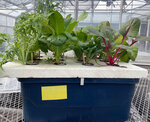

Although it’s been a mild fall so far, winter is rapidly approaching. Something that has always helped me maintain a good attitude despite Minnesota’s cold, snow, and short days, is indoor gardening. Houseplants are great, but if you want a fun winter project with lots of other benefits, you might consider hydroponic gardening! There are a range of options with different costs, levels of complexity, and time commitments required. And there’s nothing like picking some fresh homegrown herbs or veggies when the snow is blowing outside.
Hydroponics is a method of growing plants directly in water, without soil. It is efficient, using less space and (perhaps surprisingly) less water than gardening in soil. There are no weeds to deal with, and although there are some possible pests and diseases, the risk is lower than with traditional gardening. An added benefit, in my opinion, is that a hydroponic system can help humidify indoor air, making your house more comfortable during the winter months.
Essentially, in a hydroponic system, plant leaves are exposed to light (generally from a grow light or other artificial lighting, when indoors) and plant roots are exposed to water and air through various methods. Nutrients are mixed into the water, including phosphorus, nitrogen, and calcium. Generally, plants grow in a substance like coconut coir, vermiculite, or LECA, which do not provide nutrients but are used to support the plant roots and help the roots absorb water more effectively.
There are a number of options for hydroponic systems, but I’ll start with the easiest. One option is to simply purchase a pre-designed home hydroponic system. This can be more expensive than DIY, but it is an easy way to dip your toes into the world of hydroponics. You can purchase pre-designed hydroponic kits that include everything you need to get started, including seeds, grow lights, nutrients, and more, in a convenient package. Personally, I have grown herbs in a small Aerogarden for many years and really appreciate how simple it is.
Another easy option is a “wick” system, where water moves into a plant’s roots zone via a wick made of rope or felt. Essentially, the plants are grown in a growing medium that transports water well, like coconut coir or vermiculite. Nearby, there is a container of water and nutrients. One end of the wick is placed in the water, and the other end in the bottom of the plant pot. As the growing medium dries out, more water is naturally pulled up the wick to keep the roots moist. This is a type of passive hydroponics, meaning that no pumps are needed and it does not use electricity. It works best for smaller plants like leafy greens or herbs. If you search for “2-liter bottle hydroponic garden” you can find instructions for a very small and simple wicking hydroponic system using only a few simple materials (this is also a great project for kids!).
Moving up the scale of complexity, you could also try a type of system called “Deep Water Culture.” In this method, plants are suspended above a container of water and nutrients, and the roots hang down into the container. This is a relatively simple and inexpensive DIY project – you could take a 5-gallon bucket or plastic tote, cut holes in the top and insert plastic net pots, and grow your plants in the pots using a growing medium. To increase the amount of oxygen in the water, you can add a small air pump designed for hydroponics.
“Ebb and flow” is another type of hydroponic system that is somewhat more complicated, but is highly customizable and can be a fun project for a committed home gardener. In this method, plants are grown in a tray filled with growing medium. The tray is periodically flooded with water and nutrients, which then drain out of the tray. This is generally accomplished with a water reservoir, a pump to flood the tray, and a timer to schedule the flooding cycle. Water then drains back into the reservoir using gravity.
If you want to know more, there are tons of tips online for these and other types of DIY hydroponic systems, including an excellent and comprehensive article on the University of Minnesota Extension website. Additionally, a book I personally like that has detailed plans and instructions is “DIY Hydroponic Gardens” by Tyler Baras. If you’re looking for a fun winter gardening project and a way to grow food at home throughout the year, I hope you’ll give hydroponics a try!
For more information, check out the University of Minnesota Extension Yard and Garden website. Extension resources are written by experts, and contain the latest and most reliable research-based information. Happy gardening!
Comments
No comments on this item Please log in to comment by clicking here